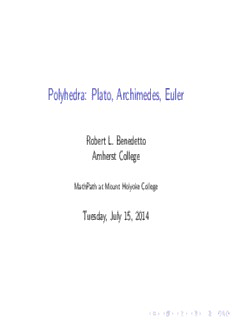
Polyhedra: Plato, Archimedes, Euler - Amherst College PDF
Preview Polyhedra: Plato, Archimedes, Euler - Amherst College
Polyhedra: Plato, Archimedes, Euler Robert L. Benedetto Amherst College MathPathatMountHolyokeCollege Tuesday, July 15, 2014 Regular Polygons Definition A polygon is a planar region R bounded by a finite number of straight line segments that together form a loop. If all the line segments are congruent, and all the angles between the line segments are also congruent, we say R is a regular polygon. Polyhedra Definition A polyhedron is a spatial region S bounded by a finite number of polygons meeting along their edges, and so that the interior is a single connected piece. So these are not polyhedra: But these are: Regular Polyhedra Definition Let S be a polyhedron. If (cid:73) all the faces of S are regular polygons, (cid:73) all the faces of S are congruent to each other, and (cid:73) all the vertices of S are congruent to each other, we say S is a regular polyhedron. Cube (Regular Hexahedron) Regular Octahedron Another Regular Polyhedron Regular Tetrahedron Two More Regular Polyhedra Regular Dodecahedron Regular Icosahedron And They’re Dual: Some Ancient History (of Regular Polyhedra) (cid:73) Pythagoras of Samos, c.570–c.495 BCE: Knew about at least three, and possibly all five, of these regular polyhedra. (cid:73) Theaetetus (Athens), 417–369 BCE: Proved that there are exactly five regular polyhedra. (cid:73) Plato (Athens), c.426–c.347 BCE: Theorizes four of the solids correspond to the four elements, and the fifth (dodecahedron) to the universe/ether. (cid:73) Euclid (Alexandria), 3xx–2xx BCE: Book XIII of The Elements discusses the five regular polyhedra, and gives a proof (presumably from Theaetetus) that they are the only five. For some reason, the five regular polyhedra are often called the Platonic solids. There Can Be Only Five: Setup Given a regular polyhedron S whose faces are regular n-gons, and with k polygons meeting at each vertex: 1. k ≥ 3 and n ≥ 3. 2. S is completely determined by the numbers k and n. 3. S must be convex: For any two points in S, the whole line segment between the two points is contained in S. 4. Since S is convex, the total of angles meeting at a vertex of S is less than 360 degrees. (cid:16)180(n−2)(cid:17)◦ 5. Each angle of a regular n-gon has measure . n [Triangle: 60◦, Square: 90◦, Pentagon: 108◦, Hexagon: 120◦.] There Can Be Only Five: Payoff From Previous Slide: The regular polyhedron S is determined by n ≥ 3 (faces are regular n-gons) and k ≥ 3 (number at each vertex). But total angles at each vertex must be less than 360◦. (cid:73) Triangles (n = 3): (cid:73) k =3 triangles at each vertex: Tetrahedron (cid:73) k =4 triangles at each vertex: Octahedron (cid:73) k =5 triangles at each vertex: Icosahedron (cid:73) k ≥6 triangles at each vertex: Angles total ≥360◦. NO! (cid:73) Squares (n = 4): (cid:73) k =3 squares at each vertex: Cube (cid:73) k ≥4 squares at each vertex: Angles total ≥360◦. NO! (cid:73) Pentagons (n = 5): (cid:73) k =3 pentagons at each vertex: Dodecahedron (cid:73) k ≥4 pentagons at each vertex: Angles total >360◦. NO! (cid:73) n-gons (n ≥ 6): (cid:73) k ≥3 n-gons at each vertex: Angles total ≥360◦. NO!
Description: